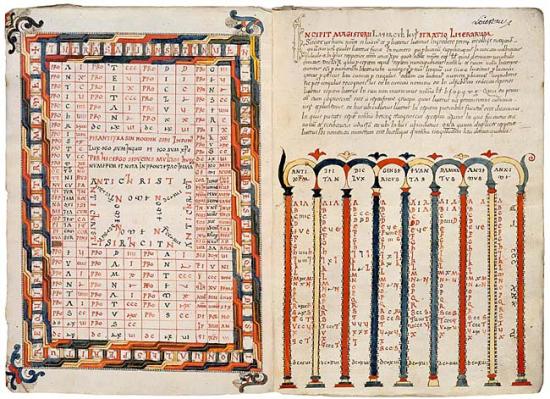
Two Antichrist Tables
Miscellaneous documents, letters, and treatises in Spanish, Latin, and Greek relating to Aragon, as well as seven watercolors after the Fanlo Beatus.
These watercolors, commissioned by Vincenio de Lastanosa of Huesca in 1635, are copies of a now lost Beatus then in the monastery of Montearagón. The original manuscript was a gift of King Ramiro I of Aragon (1035–1064) to Abbot Banzo of the monastery of San Andrés de Fanlo. It probably originated at the monastery of San Millán de la Cogolla in La Rioja, for it copies the Escorial Beatus that was made there.
Although the Apocalypse text does not include Antichrist tables, Beatus supplied them to simplify calculating the number of the Beast from the names for the Antichrist. In the first table the names are written vertically in black: Antichrist is first (followed by three other names in columns 5, 8, and 11). Each letter is given a numeric value in red in the next column. There are three more names in the bottom part. The second table is clearer. Antichrist, along with his seven other names, is inscribed below the arches (Teitan, Diclux, Gensericus, Evantas, Damnatus, Antemus, and Anxime). The alphabet beneath each name gives the numeric value of each letter. Added up, the numbers of each column yield 666 (DCLXVI at the bottom).
The Apocalypse, or Book of Revelation, is not only the last Book of the New Testament, but its most difficult, puzzling, and terrifying. It provided challenges to medieval illustrators and was the source for a number of popular images, such as Christ in Majesty, the Adoration of the Lamb, and the Madonna of the Apocalypse and contributed to the widespread use of the Evangelists' symbols.
Selected images from Apocalypse Then: Medieval Illuminations from the Morgan, an exhibition held at the Morgan are presented here. The exhibition celebrates the completion of a facsimile of the Morgan's Las Huelgas Apocalypse—the latest dated (1220) and largest surviving manuscript of a Spanish tradition of illuminated commentaries on the Apocalypse by the monk Beatus of Liébana. The series of manuscripts constitutes Spain's most important contribution to medieval manuscript illumination.
The Las Huelgas Apocalypse contains three sections: the prefatory cycle, the Apocalypse, and the Book of Daniel.
In addition to forty-nine images from the Las Huelgas Apocalypse, six images from other manuscripts in the Morgan's collections, including the earliest Beatus painted by Maius and one by the Master of the Berry Apocalypse, are in this presentation.
